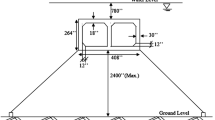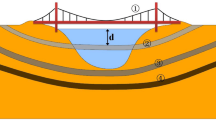Abstract
Submerged Floating Tunnel (SFT) is a new structural concept for crossing water. The purpose of the present study is to develop a dynamic analysis program for SFT and investigate dynamic response characteristics of SFT subjected to external environmental wave load. The structure is modeled with 3-dimensional beam element and the fluid is assumed incompressible, invicid and irrotational and is analysed by boundary element method applying linear potential theory. Using the hydrodynamic coefficients of added mass, radiation damping and wave excitation force obtained by solving 2-dimensional diffraction problem, 3-dimensional structural analysis of SFT is performed in time domain and results are presented. The depth effect of SFT location on the hydrodynamic coefficients are illustrated as well as the effect of the frequency dependency of the coefficients which is taken into account in the analysis program.
Similar content being viewed by others
References
Chakrabarti, S.K. (1987).Hydrodynamics of Offshore Structures, Computational Mechanics Publications.
Cummins, W.E. (1962).The impulse response function and ship motions, David Taylor Model Basin, Report 1661, Washington D.C.
Fogazzi, P. and Perotti, F. (2000). “The dynamic response of seabed anchored floating tunnels under seismic excitation.”Earthquake Engineering and Structural Dynamics, pp. 273–295.
Janardhanan, K. and Price, W.G. (1992). “Generalized Fluid Impulse Functions for Oscillating Marine Structures.”Journal of Fluids and Structures 6, pp. 207–222.
Kunisu, H., Mizuno, S., Mizuno, Y., and Saeki, H. (1994). “Study on submerged floating tunnel characteristics under the wave condition.”Proc. of 4th Int. Offshore and Polar Eng. Conf., ISOPE, Vol. II, pp. 27–32.
Larssen, R.M., Remseth, S., and Leira, B.J. (1994). “Parameter sensitivity of predicted extreme response for a submerged tubular bridge.”Strait Crossings 94, pp. 607–613.
Loken, A.E., Carlsen, H., Oftedal, R.A., and Kamsvag, F. (1990). “Comparison between hydrodynamic numerical methods and results from model tests for submerged floating tube bridges.”Strait Crossings 90, pp. 427–434.
Morita, S., Yamashita, T., Mizuno, Y., Mineta, M., and Kurosaki, K. (1994). “Earthquake response analysis of submerged floating tunnels considering water compressibility.”Proc. of 4th Int. Offshore and Polar Eng. Conf., ISOPE, Vol. II, pp. 20–26.
Paik, I.Y., Kwon, J.S., Lee, W.P., and Chang, S.P. (2002). “Dynamic Analysis of Floating Bridge with Discrete Pontoons.”Journal of Korea Society of Civil Engineers, Vol. 22, No. 2-A, pp. 327–336.
Remseth, S., Leira, B.J., Okstad, K.M., Mathisen, K.M., and Haukas, T. (1999). “Dynamic response and fluid/structure interaction of submerged floating tunnels.”Computers and Structures, pp. 659–685.
Author information
Authors and Affiliations
Corresponding author
Rights and permissions
About this article
Cite this article
Paik, I.Y., Oh, C.K., Kwon, J.S. et al. Analysis of wave force induced dynamic response of submerged floating tunnel. KSCE J Civ Eng 8, 543–550 (2004). https://doi.org/10.1007/BF02899580
Received:
Accepted:
Issue Date:
DOI: https://doi.org/10.1007/BF02899580




